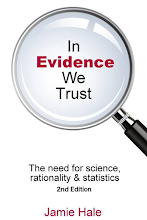Why are correlation studies important? Stanovich (2007) points out the following:
“First, many scientific hypotheses are stated in terms of correlation or lack of correlation, so that such studies are directly relevant to these hypotheses."
"Second, although correlation does not imply causation, causation does imply correlation. That is, although a correlational study cannot definitely prove a causal hypothesis, it may rule one out."
"Third, correlational studies are more useful than they may seem, because some of the recently developed complex correlational designs allow for some very limited causal inferences."
"…some variables simply cannot be manipulated for ethical reasons (for instance, human malnutrition or physical disabilities). Other variables, such as birth order, sex, and age are inherently correlational because they cannot be manipulated, and, therefore, the scientific knowledge concerning them must be based on correlation evidence.”
When practical, evidence from correlation studies can lead to testing that evidence under controlled experimental conditions.
In conclusion, it is true that correlation does not necessarily imply causation, however causation does imply correlation. Correlational studies are a stepping-stone to the more powerful experimental method.
Notes:
There are two major problems when attempting to infer causation from a simple correlation- 1) directionality problem- before concluding that a correlation between variable 1 and 2 is due to changes in 1 causing changes in 2, it is important to realize the direction of causation may be the opposite, thus, from 2 to 1 -2) third-variable problem- the correlation in variables may occur because both variables are related to a third variable
Complex correlational statistics such as path analysis, multiple regression and partial correlation “allow the correlation between two variables to be recalculated after the influence of other variables is removed, or ‘factored out” or ‘partialed out” (Stanovich, 2007, p. 77)
Conditions Necessary to Infer Causation (Kenny, 1979):
Time precedence: For 1 to cause 2, 1 must precede 2. The cause must precede the effect.
Relationship: The variables must correlate. To determine the relationship of two variables, it must be determined if the relationship could occur due to chance. Lay observers are often not good judges of the presence of relationships, thus, statistical methods are used to measure and test the existence and strength of relationships.
Nonspuriousness (spuriousness- not genuine): “The third and final condition for a causal relationship is nonspuriousness (Suppes, 1970). For a relationship between X and Y to be nonspurious, there must not be a Z that causes both X and Y such that the relationship between X and Y vanishes once Z is controlled” (Kenny, 1979. pp. 4-5).
References
Kenny, D. (1979). Correlation and Causality.
Stanovich, K. (2007). How to Think Straight About Psychology. Boston, MA: Pearson.




